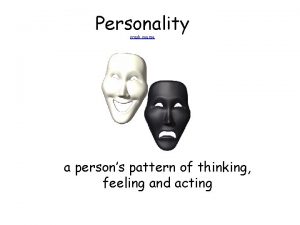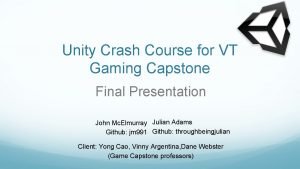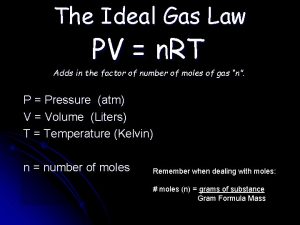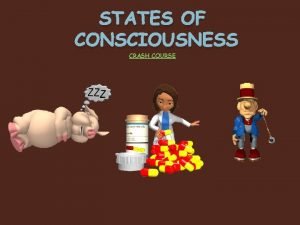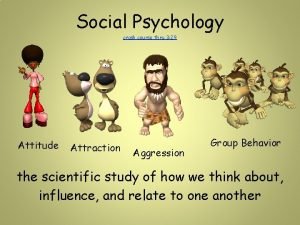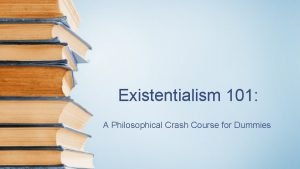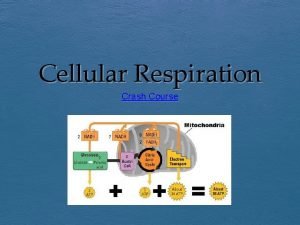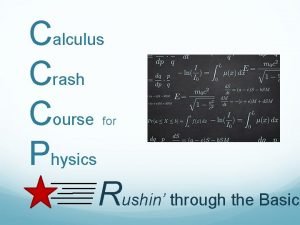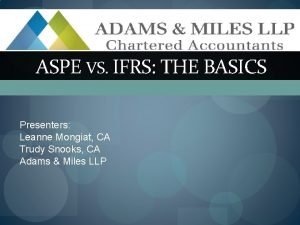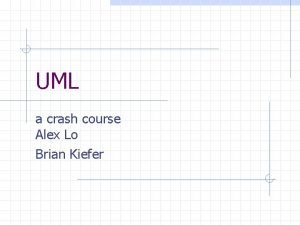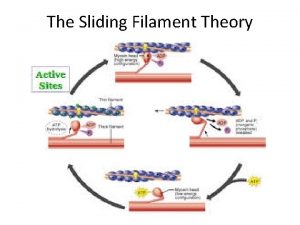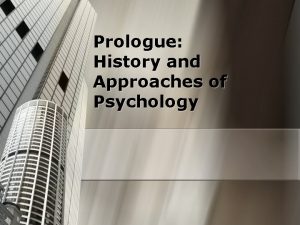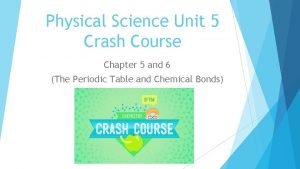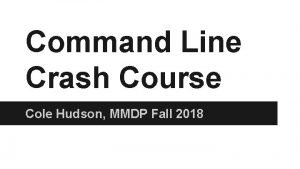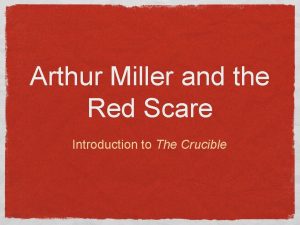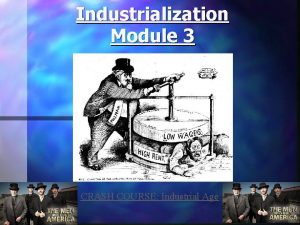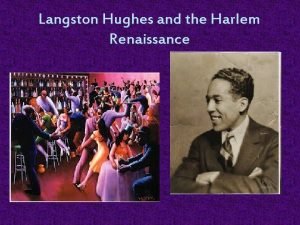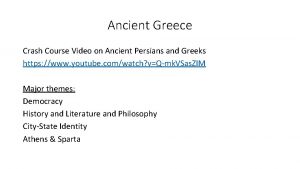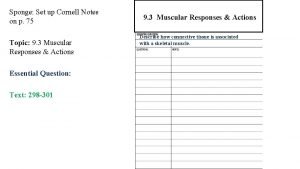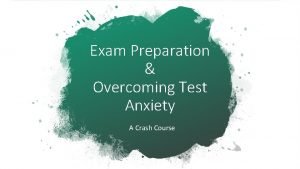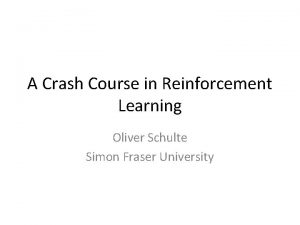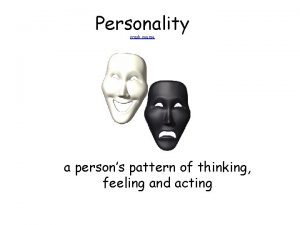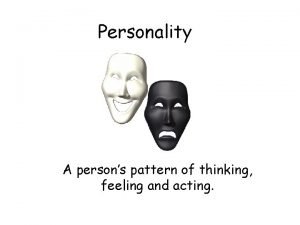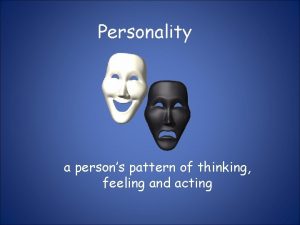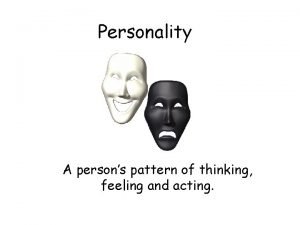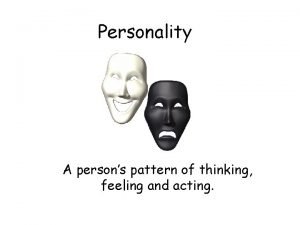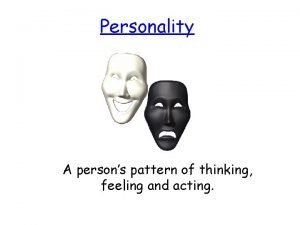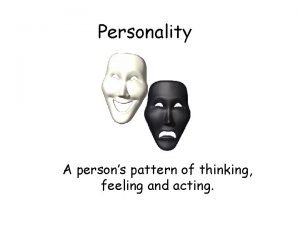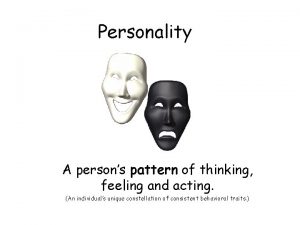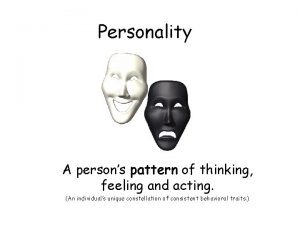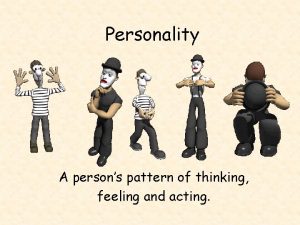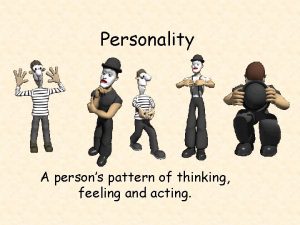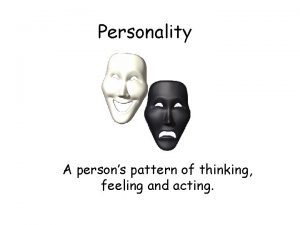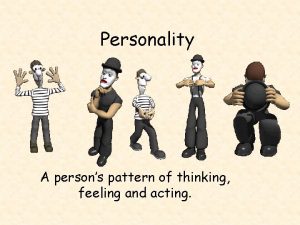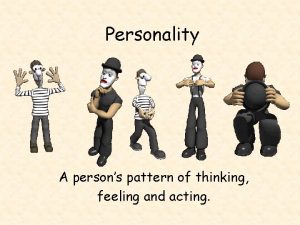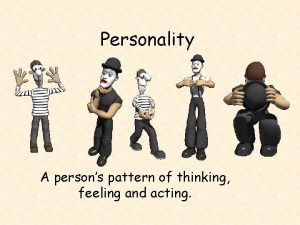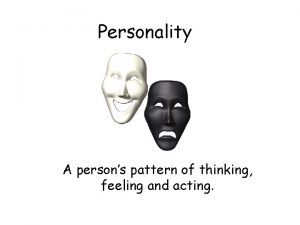Personality crash course a persons pattern of thinking
























































- Slides: 56

Personality crash course a person’s pattern of thinking, feeling and acting

Psychoanalyze Yourself Read the following questions, imagining the scenes in your mind, and write down the FIRST thing that you visualize. Do not think about the questions excessively. 1. You are not alone. You are walking in the woods. Who are you walking with? 2. You are walking in the woods. You see an animal. What kind of animal is it? 3. What interaction takes place between you and the animal? 4. You walk deeper in the woods. You enter a clearing and before you is your dream house. Describe its size? 5. Is your dream house surrounded by a fence? 6. You enter the house. You walk to the dining area and see the dining room table. Describe what you see on AND around the table. 7. You exit the house through the back door. Lying in the grass is a cup. What material is the cup made of? 8. What do you do with the cup?

This has been a relational psychology test. The answers given to the questions have been shown to have a relevance to values and ideals that we hold in our personal lives. The analysis follows: 1. The person who you are walking with is the most important person in your life. 2. The size of the animal is representative of your perception of the size of your problems. 3. The severity of the interaction you have with the animal is representative of how you deal with your problems. (passive/aggressive) 4. The size of your dream house is representative of the size of your ambition to resolve your problems. 5. No fence is indicative of an open personality. People are welcome at all times. The presence of a fence indicates a closed personality. You'd prefer people not to drop by unannounced. 6. If your answer did not include food, people, or flowers, then you are generally unhappy. 7. The durability of the material with which the cup is made of is representative of the perceived durability of your relationship with the person named in number 1. For example, Styrofoam, plastic, and paper are all disposable, Styrofoam, paper and glass are not durable, and metal and plastic are durable. 8. Your disposition of the cup is representative of your attitude towards the person in number

Psychoanalytic Theory of Personality • Sigmund Freud • Idea of the Libido moving to different parts of our body • Stages of Psycho-Sexual Development 1. Oral 2. Anal 3. Phallic 4. Latent 5. Genital 6. All relates to your childhood! What’s on our minds!!!

Freud’s View of Consciousness • Conscious- things we are aware of right now • Preconscious- things we can be aware of if we wanted to be • Unconscious- deep hidden reservoir that holds the true “us”; all of our desires and fears

Freud’s Concept of Personality (Psyche) • Id • Ego • Superego

Id • Exists entirely in the unconscious (so we are never aware of it) • Our hidden true animalistic wants and desires • Works on the Pleasure Principle – avoid pain and receive instant gratification

Ego • Develops after the Id • Works on the Reality Principle • Negotiates between the Id, the environment, and Superego • In our conscious and unconscious minds • It is what everyone sees as our personality

Superego • Develops last; about age 5 • It is our conscience (tells us the difference between right and wrong) • The Ego often mediates between the Superego and Id.

Defense Mechanisms • The Ego protects us from threatening thoughts in our unconscious ØDefense Mechanisms o Our conscious self is usually unaware of the use of defense mechanisms

Richard is dating Jasmine dumps Richard and starts dating Andrew Richard Jasmine

Repression • Pushing thoughts into our unconscious • Why don’t we remember our Oedipus and Electra complexes?

Denial • Not accepting the egothreatening truth.

Displacement • Redirecting one’s feelings toward another person or object. • Often displaced on less threatening things

Rationalization • Coming up with a beneficial result of an undesirable situation • “I really didn’t want to go to _______ anyway, it was too ____. ” • Jasmine and Richard

Projection • Believing that the feelings one has toward someone else are actually held by the other person and directed at oneself. • Jasmine and Richard?

Reaction Formation • Expressing the opposite of how one truly feels • Richard “claims” he hates Jasmine.

Regression • Returning to an earlier, comforting form of behavior. • Richard & Jasmine?

Intellectualization • Undertaking an academic, unemotional study of a topic. • Richard starts doing a research paper on failed teenage romances.

Sublimation review quiz • Channeling one’s frustration toward a different goal. • Sometimes a healthy defense mechanism • Richard learns how to play the guitar and writes songs (or starts to body build).

Criticisms of Freud • He really only studied wealthy woman in Austria. • deterministic (your actions are dictated by your past). • His results are not empirically verifiable (really hard to test). • No predictive power

Neo-Freudian Psychodynamic Theories • Carl Jung - concept of the “collective” unconscious (a common reservoir of memory traces). • Alfred Adler - studied superiority and inferiority (inferiority complex). • Karen Horney - said Freud was sexist and countered “penis envy” with “womb envy”; childhood anxiety triggers desire for love and security

Psychoanalysis, Past & Present • Hypnosis • Dream Interpretation • Free Association (having patients talk to themselves…and then interpreting the conversation) • Projective Tests (tests that delve into the unconscious) ü Examples are TAT and Inkblot Tests.

TAT Test (Thematic Apperception Test) • Give the subject a picture that is ambiguous (can have several meanings) and ask him what is occurring. • Their answers are the manifest content, supposedly revealing the latent content.




Rorschach Inkblot Test • The most widely used projective test • A set of ten inkblots designed to identify people’s inner feelings, thoughts, etc • Subjects are asked to interpret what they see in the inkblots.




Humanistic Psychology crash course; start @ 9: 53 • In the 1960’s people became tired of Freud’s negativity, trait psych’s objectivity, and behaviorist psych’s determinism. • Along came psychologists who wanted to focus on “healthy” people and how to help them strive to “be all that they can be”. • Key Figures: A. Maslow / C. Rogers

Humanistic Personality Theory • Rejects determinism (your actions are dictated by your past). • Humans have free will (ability to choose their own destiny). • Humans are innately good and as long as their self-esteem and self-concept are positive, they will be happy.

Maslow’s Hierarchy of Needs start @ 4: 50 • Abraham Maslow said we are motivated by needs, and all needs are not created equal. • We are driven to satisfy the lower level needs first. • Humans ultimately seek self- actualization (the process of fulfilling our potential; becoming our ideal self).

Maslow’s Hierarchy of Needs • Abraham Maslow said we are motivated by needs, and all needs are not created equal • We are driven to satisfy the lower level needs first • Some criticize that the order of needs are not universally fixed


Self Actualization Activity responses placed before items 2, 5, 6, 8, 9, 11, 13, & 14 should be reversed: 6=1, 5=2, 4=3, 3=4, 2=5, 1=6 ================================ total your scores : r= 15 -90 ======================================== mean= 60

Carl Rogers • The objective of humans is to become self-actualized. • Compared human potential to that of acorns • For Humans to “grow” they need: • Genuineness • Acceptance (Unconditional Positive Regard, esp. with parents) • Empathy • Congruence

Criticism of Humanistic Psychology • Reflects Western Cultural Values • Extreme Individualism leads to Narcissism • Fails to Account for Immense Evil (People are basically good? )

Trait Theory Myers-Briggs personality inventory crash course • Describe people’s personalities by specifying their main characteristics (traits – patterns of behavior or disposition to feel/act). • Traits like honesty, laziness, ambition, outgoing are thought to be stable over the course of your lives. • Often use Personality Inventories (Factor Analysis is used to cluster items and score personality “tests”. • First developed by Gordon Allport (interviewed Freud).

Trait Theory of Personality • MMPI – Minnesota Multiphasic Personality Inventory – most widely researched/used trait personality inventory • Introversion-Extroversion/Emotional Stability Scale (Eysenck) • BIG FIVE Personality Traits: • Big Five Personality test 1. Extraversion (how outgoing or shy one is) 2. Agreeableness (how easy to get along with one is) 3. Conscientiousness (hardworking, responsible, organized) 4. Openness to Experience (creativity, curiosity, etc. ) 5. Neuroticism (Emotional Stability; consistency of mood)


Trait Theory Criticism • Person-Situation Controversy (Walter Mischel) • while there’s been some evidence of persistence of traits with age, they seem to vary by situation and circumstance (aka role playing) • How consistent is your behavior in each class? social setting?

Personality Inventory • Myers-Briggs – based on the Myers-Briggs Personality Inventory • Introversion (I) vs. Extroversion (E) • Intuitive (N) vs. Sensing (S) • Thinking (T) vs. Feeling (F) • Judging (J) vs. Prospecting (P) • On which theory of personalities is this test based? • What variables might impact the results of this test other than someone’s traits? • Do you agree with the test’s analysis of your personality?

Social-Cognitive Personality Theories crash course start @ 5: 00 • Focuses on how we interact with our culture and environment • Albert Bandura ü Reciprocal Determinism (traits, environment, and behavior all interact and influence each other to form personality)

Social-Cognitive Personality Theories locus of control inventory • Rotter - “Locus of Control” – External – Internal • Seligman - “Learned Helplessness”, Optimism, & Positive Psychology

---and “self efficacy” is--- • https: //www. youtube. com/watch? v=wrzzbao m. Lmc&feature=related • https: //www. youtube. com/watch? v=1 IHA 5 g. E bus. E

Behaviorist Perspective on Personality Theories • The way most people think of personality is meaningless. • Personality changes according to the environment (reinforcers and punishments). • If you change environment then you change the personality.

Biological Perspective on Personality Theories • What % of personality variance can be attributed to genetics (heritability)? • We are not sure BUT temperaments do seem to be stable from infants to old age.

Somatotype Theory • An early biological theory by William Sheldon. • Endomorphs (Fat) tend to be friendly and outgoing. • Mesomorphs (muscular) tend to be more aggressive. • Ectomorphs (thin) tend to be more shy and secretive. • Sheldon’s research was coorelative only and has not been replicated.

Beware of the Barnum Effect ! • People have the tendency to see themselves in vague, stock descriptions of personality. • Horoscopes, astrologists, psychics, and short “personality tests” all take advantage of this tendency. What your favorite color says about you!!! What kind o f shape are yo u?

You have a great need for other people to like and admire you. You have a great deal of unused capacity, which you have not turned to your advantage. Disciplined and self-controlled outside, you tend to be worrisome and insecure inside. You prefer a certain amount of change and variety and become dissatisfied when hemmed in by restrictions and limitations. You pride yourself as an independent thinker and do not accept others statements without satisfactory proof. You have a tendency to be critical of yourself. At times you have serious doubts as to whether you have made the right decision or done the right thing. At times you are extroverted, sociable , while at other times you are introverted, wary, reserved. While you have some personality weaknesses, you are generally able to compensate for them.

Exploring the Self • Self-serving Bias – a readiness to perceive oneself favorably – People accept responsibility more readily for their successes than failures – People view themselves as better than average • Spotlight Effect – overestimating others’ noticing and evaluating one’s appearance, performance, etc.

Exploring the Self • Self-Esteem – one’s feelings of high or low self worth – High self esteem correlates with better sleep, more resistance to peer pressure, less drug use, persistence, happiness, etc.

Exploring the Self Culture & Self • Finish this sentence… • Individualism – emphasis on one’s own goals and defining one’s identity in terms of self rather than the group – Euro-centric/western cultures – wester • Collectivism – emphasis on one’s group and defining one’s identity accordingly – KEY WORD – “WE”/ Asian Cultures

• You are talking quietly with some friends at a restaurant when all of a sudden a new student at your school, Dave, sits down at your table. Dave immediately starts to tell a loud, funny story to everyone at the table while he gobbles French fries from your plate. Use the following personality theories or concepts to explain or describe aspects of Dave's behavior or thinking: – – – Psychoanalytic Perspective Trait Perspective Humanistic Perspective Social Cognitive Perspective Internal or External Locus of Control Individualism or Collectivism
 One person's trash is another person's treasure
One person's trash is another person's treasure Crash course personality
Crash course personality Crash course molecular biology
Crash course molecular biology Unity over the shoulder camera
Unity over the shoulder camera Gas laws crash course
Gas laws crash course Crash course crusades
Crash course crusades Cold war crash course
Cold war crash course Crash course psychology consciousness
Crash course psychology consciousness What example does hank green give for social loafing?
What example does hank green give for social loafing? Endo peri epi
Endo peri epi React traversy media
React traversy media Project management crash course
Project management crash course Eth meth table
Eth meth table Crash course hardy weinberg
Crash course hardy weinberg Sartre for dummies
Sartre for dummies Computer architecture crash course
Computer architecture crash course Structure of blood vessels
Structure of blood vessels Does chemiosmosis cause cramps
Does chemiosmosis cause cramps Crash course calculus
Crash course calculus Aspe vs ifrs
Aspe vs ifrs Robotics crash course
Robotics crash course Crash course wwi
Crash course wwi Uml crash course
Uml crash course Crash course sliding filament theory
Crash course sliding filament theory Data mining crash course
Data mining crash course Httpyoutube
Httpyoutube Ros crash course
Ros crash course Cognitive psychology crash course
Cognitive psychology crash course Physical chemistry crash course
Physical chemistry crash course Recovery concepts in dbms
Recovery concepts in dbms Drupal crash course
Drupal crash course The command line crash course
The command line crash course The crucible crash course
The crucible crash course English grammar crash course
English grammar crash course Weathr for tomorrow
Weathr for tomorrow Weather and climate crash course
Weather and climate crash course Crash course protestant reformation
Crash course protestant reformation Crash course skeletal system
Crash course skeletal system Industrialization crash course
Industrialization crash course Biology
Biology Crash course harlem renaissance
Crash course harlem renaissance Ancient greece crash course
Ancient greece crash course Ap language and composition crash course
Ap language and composition crash course Crash course muscles part 2
Crash course muscles part 2 Auditory learner
Auditory learner Oliver schulte
Oliver schulte Positive thinking vs negative thinking examples
Positive thinking vs negative thinking examples Thinking about your own thinking
Thinking about your own thinking Holistic thinking example
Holistic thinking example Perbedaan critical thinking dan creative thinking
Perbedaan critical thinking dan creative thinking Thinking about you thinking about me
Thinking about you thinking about me Analytical thinking training course outline
Analytical thinking training course outline One and a half brick wall
One and a half brick wall Course title and course number
Course title and course number Course interne moyenne externe
Course interne moyenne externe Characteristic pattern
Characteristic pattern Non vat receipt sample philippines
Non vat receipt sample philippines

